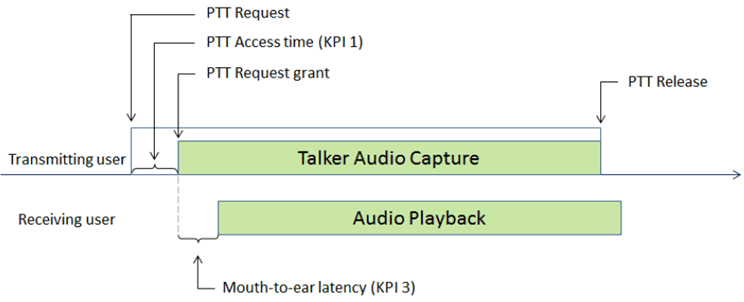Content for TS 22.179 Word version: 19.3.0
7.11 Audio MCPTT Call performance
7.11.1 MCPTT Access time and Mouth-to-ear latency
7.11.1.1 General overview
7.11.1.2 Requirements
7.11.2 Late call entry performance
7.11.2.1 General overview
7.11.2.2 Requirements
7.11.3 Audio / Voice quality
7.12 Off-network MCPTT operations
7.13 Off-network UE functionality
7.14 Switching to off-network MCPTT
7.15 Off-network recording and audit requirements
7.16 Off-network UE-to-UE Relay
7.16.1 Private Calls
7.16.2 Group Calls
7.11 Audio MCPTT Call performance p. 66
7.11.1 MCPTT Access time and Mouth-to-ear latency p. 66
7.11.1.1 General overview p. 66
For MCPTT Users, one of the most important performance criteria is the MCPTT Access time (KPI 1). The MCPTT Access time is defined as the time between when an MCPTT User requests to speak (normally by pressing the MCPTT control on the UE) and when this user gets a signal to start speaking. This time does not include confirmations from receiving users.
The Mouth-to-ear latency (KPI 3) is the time between an utterance by the transmitting user, and the playback of the utterance at the receiving user's speaker. Figure 7.11.1.1-1 illustrates the MCPTT Access time and Mouth-to-ear latency.

Figure 7.11.1.1-1: Illustration of MCPTT Access time and Mouth-to-ear latency
(⇒ copy of original 3GPP image)
(⇒ copy of original 3GPP image)
7.11.1.2 Requirements p. 66
7.11.2 Late call entry performance p. 66
7.11.2.1 General overview p. 66
An MCPTT User is able to join or leave an already ongoing MCPTT Group Call. Late call entry is the activity when an Affiliated MCPTT Group Member joins an MCPTT Group Call in which other Affiliated MCPTT Group Members are already active. The Late call entry time (KPI 4) is the time to enter an ongoing MCPTT Group Call measured from the time that the user decides to monitor such an MCPTT Group Call, to the time when the UE's speaker starts to play the audio. The performance requirements for Late call entry time only applies to when there is ongoing voice transmitted at the time the MCPTT User joins the call.
In a Late call entry there might be an initial lost audio of the voice burst sent to the new Receiving MCPTT Group Member.
7.11.2.2 Requirements p. 66
7.11.3 Audio / Voice quality p. 67
[R-7.11.3-001]
Void
7.12 Off-network MCPTT operations p. 67
[R-7.12-001]
Void
[R-7.12-002]
Void
[R-7.12-003]
Void
7.13 Off-network UE functionality p. 67
[R-7.13-001]
Void
[R-7.13-002]
Void
[R-7.13-003]
Void
[R-7.13-004]
Off-network MCPTT UEs shall support a minimum number of (N8) simultaneous off-network MCPTT calls.
7.14 Switching to off-network MCPTT p. 67
[R-7.14-001]
Void
[R-7.14-002]
Void
[R-7.14-003]
Void
7.15 Off-network recording and audit requirements p. 67
[R-7.15-001]
Void
[R-7.15-002]
Void
7.16 Off-network UE-to-UE Relay p. 67
7.16.1 Private Calls p. 67
[R-7.16.1-001]
Void
[R-7.16.1-002]
Void
[R-7.16.1-003]
Void
7.16.2 Group Calls p. 67
[R-7.16.2-001]
Void
[R-7.16.2-002]
Void